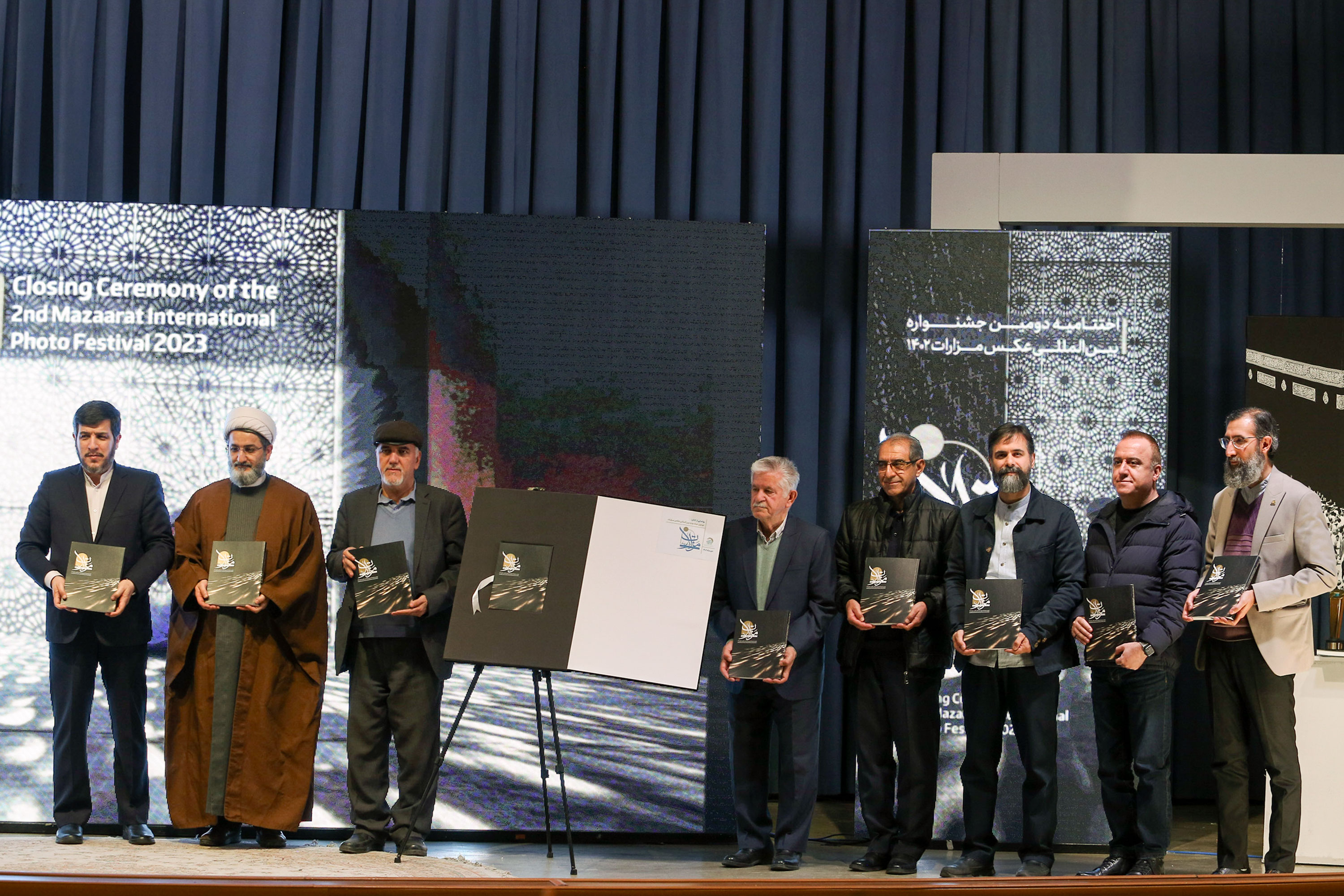

The closing of the second international photo festival "Mazarat" with the introduction of the winners
The closing ceremony of the second "Mazarat" international photo festival was held last night, January 16, in Noor Hall, Mashhad, and the winners of this festival were announced.
At the beginning of this ceremony, Amir Mehdi Hakimi, the CEO of Astan Quds Razavi Institute of Artistic Creations, considered "tombs" as a symbol, culture and identity in Shia and Islamic view and said: "tombs have been a place of civilization everywhere and many artists throughout the centuries And for years, they have performed in the graves and resting places of Islamic elders.
He added: A major part of Islamic civilization was formed in the tombs and many artists have worked hard in them. Tile work, architecture and many arts have been formed in the circle of Islamic tombs in different parts of the Islamic world.
Hakimi pointed out: On the other hand, tombs have been a platform for communication with God, and on the other hand, the relationship of humans with themselves and nature, the creation of markets and schools, and thousands of other events have been formed around tombs in the Islamic world. The photography community also tried to depict some of these events in the form of Mazarat Photo Festival.
The CEO of Astan Institute of Artistic Creations, Qods Razavi, in another part of his speech, pointed to the process of holding the second Mazarat International Photo Festival and said: In this period, 1,711 participants from 52 countries, including 718 Iranian photographers and 353 non-Iranian photographers, seven They sent 1,643 works to the secretariat of the festival, of which 5,489 works were related to Iranian photographers and 2,154 works were from photographers from other parts of the world.
He pointed out: at the end of the evaluation of the jury in 2 days of judging, 115 works from 95 photographers, including 73 works from 61 Iranian photographers and 42 works from 34 non-Iranian photographers, made it to the book of the festival and art exhibition, and at the end, 7 works to were chosen as the chosen title.
The world of existence is the manifestation of the art of Hazrat Haqq
Hojjat al-Islam "Mustafa Faqih Esfandiari" Vice President of International Affairs of Astan Quds Razavi was the other speaker of this event who in his speech considered the universe as the manifestation of the art of the Holy Prophet and said: if we want to speak artistically, we must use the two words "manifestation of art" and " Let's discuss the art of manifestation. Surely, God manifested himself artistically, the world is also a magazine of the artistic manifestations of Hazrat Haqq.
Referring to the verses of Surah Al-Hashr, he emphasized: God is definitely an artist, and the first and most important manifestation of divine art is the art of creation.
Hojjat al-Islam Faqih Esfandiari further said: The characteristic of the greatest artistic manifestation of God is that it is wide and eternal and has a belly and, because it has a divine color and smell, it can be authentic.
He added: Another divine art is "presentation", which beautifully presented its art and asked us to reflect on this creation.
Ziyarat is that "Mazur" is also a guest of "Pilgrim".
Dr. Abdulhamid Talebi, the head of the scientific and cultural organization of Astan Quds Razavi, also pointed out some aspects of pilgrimage and said: Pilgrimage to a holy place brings people closer to God and causes one or more spiritual events to happen in a person's life.
He added: Pilgrimage is not only the presence of pilgrims in the vicinity of Mazor, and it is not that only pilgrims are guests of Mazor. Rather, it is a pilgrimage where the pilgrim is also a guest.
Talebi pointed out: We, who go to visit our religious elders, should test ourselves whether their guidance has come to life in our lives or not. In other words, as long as their guidance comes alive in our hearts, our pilgrimage is accepted, and this is the sublime and knowledgeable pilgrimage that is on the way to meeting God.
In another part of his speech, the head of the scientific and cultural organization of Astan Quds Razavi did not consider pilgrimage to be exclusive to Shiites and said: According to historical sources, Muslims always visited the graves of their elders, and the Prophet's shrine has been a pilgrimage site for all Muslims since the beginning. .
He added: Pilgrimage places in the Islamic world also have high religious and cultural values among Muslims and can strengthen Islamic unity and cohesion between Muslims and Islamic countries.
Talebi considered art to be a deep relationship between man and the world of meaning and said: Art is a mutual understanding between wisdom and truth. The artist also has a message in his mind and consciousness and wants to convey it to others with his special elegance and beauty that others are not able to do.
He added: In this festival, with your art, you artists have beautifully shown the relationship between pilgrims and pilgrims in the form of spiritual events, and the art of artists in holy shrines and holy courts, and pilgrimage as a factor of Islamic unity and cohesion. You have fixed and depicted Muslims.
Winners of the second Mazarat festival
In the final part of this ceremony, the statement of the jury was read and the best people were introduced in the 2 sections of shrines and prayers.
According to the judges of the festival, "Mohammed Ahangar" from Ahvaz city, "Jaber Gholami" from Arak city and "Amir Mahdi Najaf Lo Shahpar" from Hamedan city won the first to third places respectively.
In the prayer section, "Sheikh Rihan Ahmed" from Bangladesh, "Mustafa Saeedi" from Bojnord and "Cristina Garzon" from Italy took the first to third places.
The festival secretary's special award was also awarded to "Majmedhosein Esmaili" from Isfahan city.
It should be noted that the first prize was 1,500 euros, the second prize was 1,000 euro, and the third prize was 750 euro.
In this ceremony, "Farshid Ahmadpour" was also awarded the golden badge of the Razavi Art School for editing the book of the collection of architectural photos of the Razavi Holy Shrine.